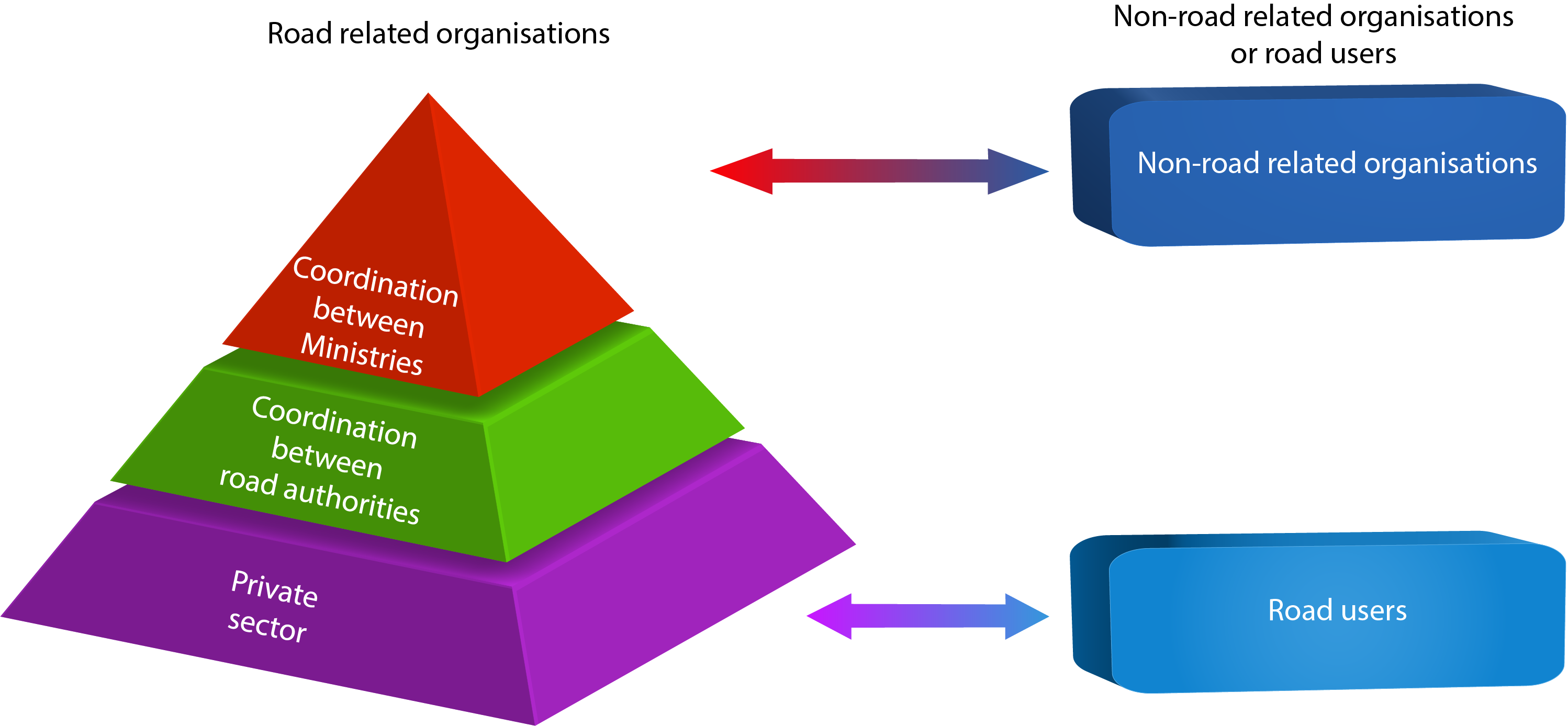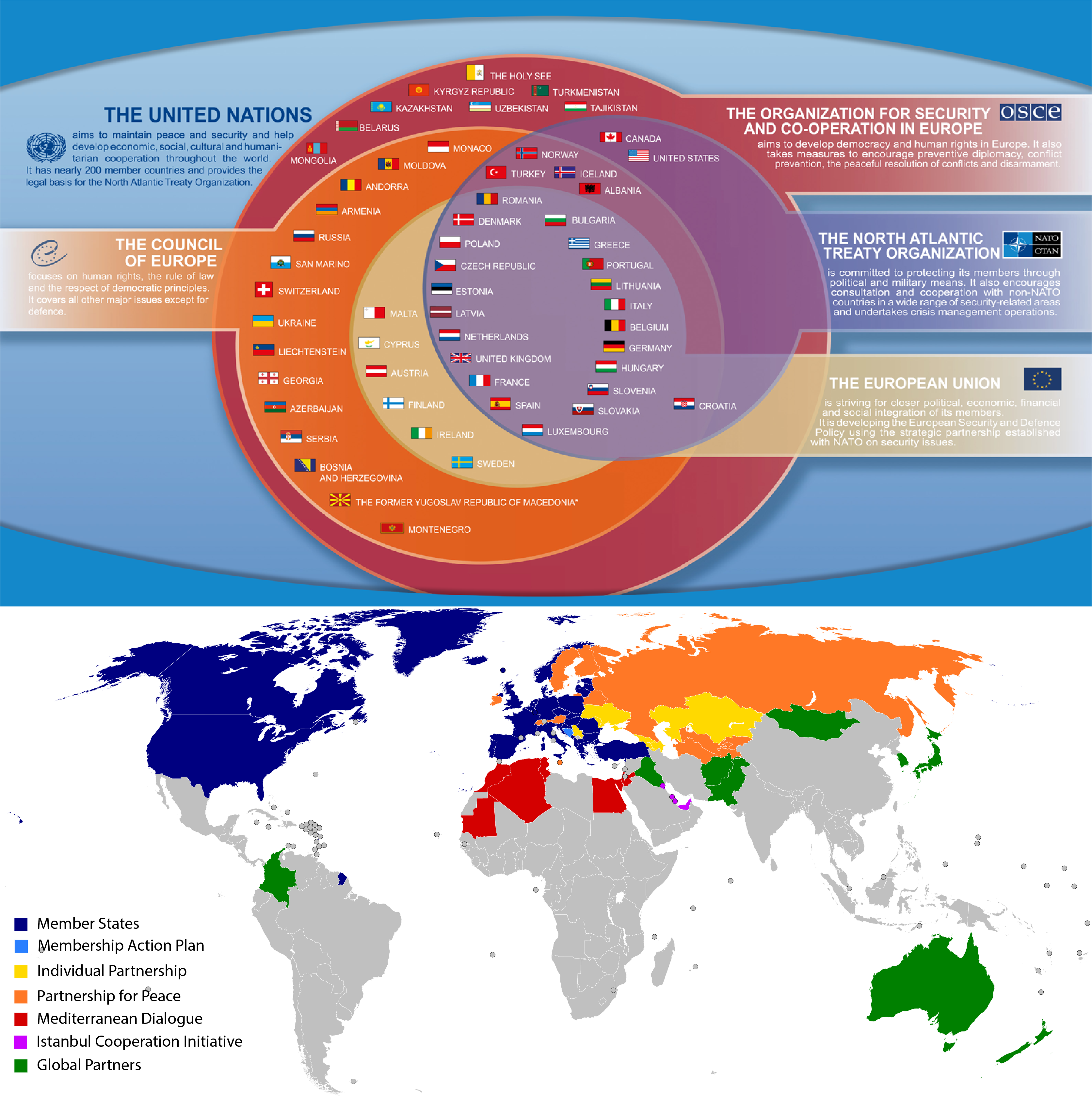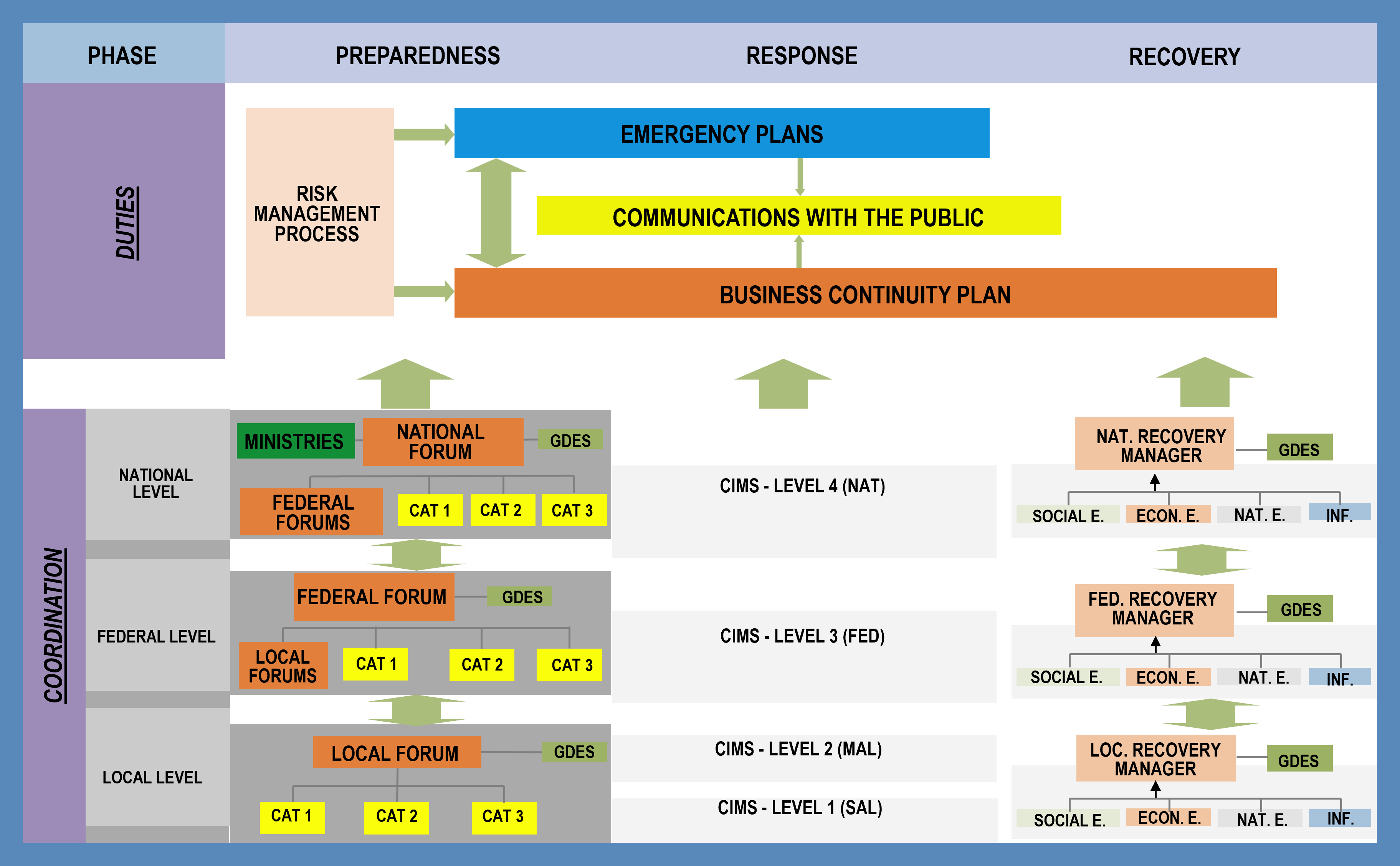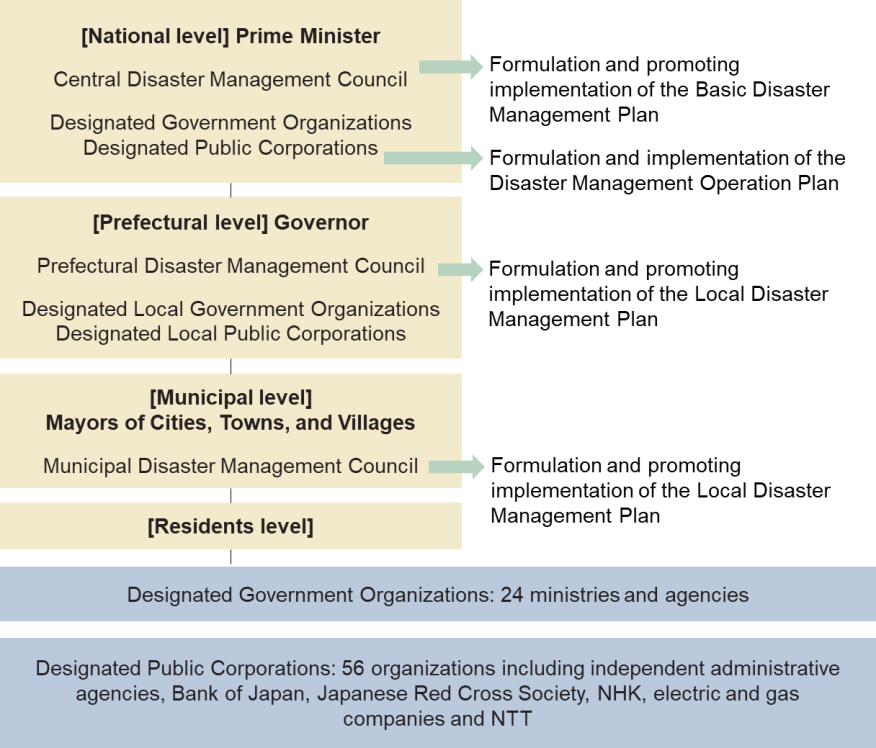

Excellent coordination and cooperation among the parties involved in emergency situations is required for successfully managing these. A legal framework is needed to define the respective responsibilities, key roles and competences of participating entities. Figure 4.3 shows an interrelation diagram of road-, non-road-related and road users in coordinative and cooperative actions in emergency situations.
Clear legal responsibilities covering a range of activities and timeline for emergency management, from planning to restoration of an affected area, is of paramount importance to successful implementation of such framework.
National and local governments, related coordination bodies for disaster management at national and local levels as well as the private sector and road network stakeholders, need to establish a well-defined emergency management system with clear actions to be taken in each stage of the emergency management process: prevention/preparedness, emergency response and recovery/rehabilitation.
Road traffic can be affected from a range of situations, ranging from slight traffic disruptions to extensive disruptions and damages in transportation technology, infrastructure and systems. The consequences of natural and man-made hazards that result in emergency situations are even more pronounced in extreme and complex situations that are defined as crises.
The aim of an organization is to anticipate and adequately respond to emergency situations in the form of contingency planning and by creating the necessary material, financial and human resources needed to address the emergency.
Management of emergency situations consists of institutional and functional components. The institutional component describes the type of emergency situations, the managerial hierarchy and the functionality, competencies, relationships and constraints of the interconnected organizational elements needed to address the situation. The functional component involves a comprehensive set of action plans, experiences, recommendations and measures to be used by organizations responsible for contingency planning and emergency situation management.

Figure 4.3-1 Interrelations of road-, non-road-related and road users in coordinative and cooperative actions in emergency situations
Safety is ensured independently, but also in close cooperation with various international organizations, the signatory and regulatory agreements of which are binding on Member States.
NATO is an example of an intergovernmental organization with shared values, a common determination to defend them and with available resources and measures that provide the capacity do so whenever and wherever necessary. NATO cooperates with governmental and non-governmental organizations (NGOs).
With the need for greater solidarity in today’s security environment, NATO´s Partnership policies have been steadily extended with a view to build closer and more effective relationships with numerous countries and international institutions. This involves enhanced cooperation on civil emergency planning, including the possibility, in case of disaster situations, to request the assistance of the Euro-Atlantic Disaster Response Coordination Center (EADRCC), which is based at NATO Headquarters in Brussels, Belgium.
The EADRCC was established in 1998 and is a partnership instrument open to 69 countries. Its role is limited to coordination of allied and partner nations’ assistance to each other in case of natural or technological disasters and acts as a focal point for information sharing. It works closely with the relevant United Nations (UN) and other international organizations that play a leading role in responding to disaster situations for which it also offers liaison arrangements such as between the UN Office for the Coordination of Humanitarian Action (UN-OCHA) and the EU. A permanent liaison officer from the UN Office for the Coordination of Humanitarian Affairs is assigned to the EADRCC staff.
Since its foundation, it has received more than 60 requests for international assistance for crises concerning earthquakes, floods, forest fires, mudslides, storms, extreme weather, pandemics, tsunamis, technological disasters, humanitarian emergencies, assistance to massive events (e.g. assistance to Greece during the Olympic Games), hurricane Katrina and Pakistan monsoon floods among others.
EADRCC can also address crisis situations in Partner countries, the wider Mediterranean region, the broader Middle East and in ‘contact countries’ such as Japan, Australia, Pakistan and China. EADRCC closely cooperates with other international organizations such as the European Union, the Organization for Security and Cooperation in Europe and the United Nations (see Figure 4.3.1). These policies have put the spotlight on the major contribution to international security that strengthened cooperation can offer.
The Centre has developed state-of-art operating procedures to ensure rapid responses in emergencies and encourages participating countries to develop bilateral or multilateral arrangements to address issues such as visa regulations, border crossing requirements, transit agreements and customs clearance procedures that can delay channeling of rescue aid to a disaster location.
The EADRCC organizes regular major disaster training exercises in different participating countries designed to practice procedures, provide training for local and international participants, build up interoperability skills and capabilities and harvest the experience and lessons learned for future operations.

Figure 4.3.1 Interrelations of NATO with other international organizational bodies
The National Security System provides the organizational and regulatory framework for cooperation and coordination in emergency situations.
A National Security System can be defined as a system of administrative authorities, local governments, armed forces, emergency services, legal entities and individuals, and their relationships and activities. The scope of this system is to ensure a coordinated approach to enable fulfillment of basic obligations of the state in securing sovereignty and territorial integrity, and in protecting democratic principles, life, health and property of the population.
The National Security System is designed to comply with the Constitution and its essential elements are constitutional bodies and institutions. Ensuring security is based on a comprehensive approach, which includes designing appropriate mechanisms for managing risk or crisis situations and properly planning for related needs.
The National Security System serves as the institutional framework in creating and implementing related policies and is composed of physical and legal entities. Its basic function is the management and coordination of the various organizations responsible for national security interests. In creating a National Security System, political, military, economic, financial, legislative and social factors need to be accounted for effective risk management. Interactions and relationships among these factors need also to be defined for determining the responsibilities and obligations of the different organizations.
Such structure usually includes the President or Head of State, Parliament, Government, National Security Council and its working bodies, the Central Administration, regional and municipal authorities, the Armed Forces, Intelligence Services, rescue services, health and emergency response services. The Government is responsible for formulating basic policies, strategies and guidelines for disaster reduction and for securing coordination of government disaster reduction activities. Ministries and Agencies have responsibility to take actions related to disaster reduction within their own mandates. A Supreme Executive Authority is responsible for managing and operating the entire security system.
Creating a national security system is a long and difficult process. Legislation is required to define the purpose of individual entities and determine their interactions and obligations to civic life in the law-making process. Legislation often plays a decisive role in emergency management as it affects all stages involved in emergency situations.
A functional security system is not only a tool for effective crisis management, but also enhances prevention of- and preparation for potential crises, their early identification and warning. It is an open and dynamic system, as it must constantly respond to changes in the security environment and emerging threats. Building experience and developing economic and financial viability in such systems is a long-term and arduous process involving both systematic training and real-case experience.
Security measures involve ensuring defense against external military threats, protecting internal order and security, safeguarding the economy and protecting the population from the effects of natural and man-made disasters, including violent social conflicts. Experiences from developed countries clearly indicate that the aforementioned issues are interconnected and need to be addressed on a common basis when planning related measures.
In addressing major emergency situations, we can identify three levels of coordination based upon the magnitude of the emergency:
These levels involve strategic, operational and tactical components of coordination and cooperation but are also emergency management stage-specific. Integrated Rescue System (IRS) provides a framework for efficient use of resources and cooperation capabilities in emergency situations. Next, the IRS and the different levels of cooperation and coordination are described.
IRS is an effective system of links, rules of cooperation and coordination of rescue teams and security forces, state and local governments, individuals and the private sector in the implementation of common rescue and relief work and in the preparation for emergencies.
IRS aims, while taking into account the legal framework, in integrating and combining every available material and human resources to perform rescue in the most efficient and economical use. An IRS is not an organization in the form of institutions, but above all an expression of rules and cooperation.
The components IRS are divided into the following:
The strategic level for coordination and cooperation lies basically within the government and its supreme leader (e.g. Prime Minister). The government defines the strategic directions in security matters and addresses challenges by forming national plans and programs that are subsequently further elaborated within regional and local governmental units to reflect local particularities. The emergency management process is competed when road users and the private sector are included in the risk management framework.
As the primary concern of emergency management is protection of the population, usually the supreme government authority responsible for the strategic level of coordination is the Ministry of the Interior, which controls the emergency response services and the security services (i.e. fire department, police) or other specialized agency created for emergency management.
For the road transport sector, the relevant authority it is usually a ‘Department of Transportation’ type of body responsible for dealing with emergencies affecting the road network. A permanent working body in the Government, whose members are the highest representatives of the authorities and ministries ensures interministerial coordination and cooperation in the development of strategic plans and policies for emergency situation management. Its main task is to participate in the creation of a reliable national security system and fulfill international obligations. Experts from different sectors (e.g. representatives from the private sector or academia) can supplement such committees to ensure high quality of decision-making in determining appropriate course of action.
Various goal-oriented working committees focusing on individual areas of security are working at a national, regional and local level, to ensure co-ordination in preparation for disasters and crisis situations in their area of competence. These, are usually presided by the highest elected representatives of members if the cabinet, regions, cities and municipalities.
For emergency situations of national implications, a national risk management working body is formed for emergency situation management. Primarily, elected bodies and senior management, especially from national and regional levels, ensure the coordination at the strategic level.
Coordination at the operational level is implemented at all levels concerned with the use of various forms of business operations and information centers that coordinate rescue system components.
Operational management is usually carried out in specific organizational structures tailored to deal with temporary tasks. Such structures have more narrow and focused expertise based on the skills and experience of the individual team members. Actions are more random and follow tested practices under normal operating conditions. This implies that these teams strongly relate on individual initiative and leadership and often improvise to solve ad-hoc problems.
Care must be applied to maintain continuous communication between the working groups and the control center, which should be located in a structure, which enables proper guidance in managing the emergency situation without being hampered from the situation. Organizing such special-purpose structures for emergencies must take into account weather conditions, light conditions, supplies and the protective equipment that should be used due to the risk environment in which work tasks are performed. These working groups should not be logistically restrained when operating under adverse circumstances.
Streamlining the procedures involved in emergency situations calls for the application of modern management techniques and process automation in order to minimize errors and conserve a logical sequence of individual activities. Methodologies must be clear and suit the competences of the operational taskforce. Using data processing methods that take into account the stochastic nature of natural phenomena and allow for temporal analysis of data obtained from road networks is possible to record the sequence of the management process. Follow up and post-event derived lessons are essential in developing integrated methodologies that properly account for the needs of emergency situations and provide adequate logistic support.
Support centers can be established to provide coordination of activities and information exchange and sharing on the status of the emergency situation among the entities involved in management of emergency situations. Private or public entities important for maintaining the operation of the state such as lifeline utilities are often required by law to possess business continuity plans, contingency plans and emergency preparedness plans to ensure operational continuity of services and entities involved in emergency management.
Permanent operational centers are often crucial in resolving the crisis. These, constitute links between public and private sector organizations, including NGOs, and provide information support and resources to all factors involved in emergency management, particularly at regional and local levels.
Cooperation and coordination with the private sector and NGOs is provided mostly at the regional and local level where their knowledge specific to the environment of the affected area comes highly in use. Representatives of these organizations are actively integrated into taskforce teams especially at local or regional levels.
Other cooperation involves active participation and assistance in dealing with the consequences of disasters of organizations that are not directly related to the maintenance and repair of roads and highways, such as automakers and navigation device manufacturers.
At the tactical level, coordination involves mainly relating resources and teams deployed directly on the site of an emergency (e.g. fire brigade, army, police, health services, etc.).
An effective system of links, rules of cooperation and coordination of rescue and security forces, state and local governments, individuals and the private sector in the implementation of common rescue and relief work and preparation for emergencies is an integrated rescue system.
Principle of integration lies in the fact that each source - material and human, but also legal, combine to perform rescue or disposal, to their most efficient and economic use.
The three (3) stages of the emergency management process (preparedness, response and recovery) imply differences in the coordination and cooperation process. The following description aims to provide a generalized framework of practices observed in countries that are considered among the most advanced in terms of emergency management for each of the three stages.
The organizations implicated at each level of coordination (national, regional, local) can be distinguished into those that are core to the emergency management process (Category 1 – e.g. civil protection, local authorities, etc.), those that assume a supporting role (Category 2 – e.g. lifeline utilities agencies, transportation, etc.) and those that are auxiliary and can be used on a per case basis (Category 3 – e.g. volunteers, NGOs, etc.). Usually, in an emergency, the road sector belongs to the supporting organizations.
Resilience forums (national, regional and local) composed from representatives of all parties involved in this stage can be established to ensure appropriate coordination and cooperation. To facilitate two-way communication and information sharing between Category 1 and 2 responders and central government, standing members of the local resilience forums can form General Divisions for Emergency Situations (GDES) offering advice and encouraging cross-boundary working and sharing of good practice at all levels of coordination 1.
A coordinated incident management system (CIMS) 2 is proposed to ensure proper coordination so that:
The CIMS is composed from four (4) elements: Control/Management, Planning with data collection and analysis, Operations and Supplies. According to CIMS, the first responder to the emergency site assumes the management role. Emergency situation management transition is performed according to predetermined procedures.
CIMS is followed at the three levels of coordination with an inclusion of a sub-level at the local level according to whether multiple agencies (MAL) or a single agency (SAL) are involved in the emergency response.
The recovery stage constitutes a restoration of the quality of life of a community after an emergency situation. Recovery from an incident is unique to each community and depends on the amount and kind of damage caused by the incident and the resources that the jurisdiction has ready or can quickly obtain 3. Recovery is managed with logic similar to that of the Preparedness stage. For determining who is involved in the recovery stage one needs to examine the impact of the disaster in the following four elements:
Task groups from each of the affected environments and sub-task groups specific to the emergency situation need to be formed at all levels aiming to:
A recovery manager (REC. MANAGER) coordinates these task groups. Respective GDES groups can facilitate information sharing and communication.
Figure 4.3.7 shows the coordination structure for the different levels and stages of the emergency management process.

Figure 4.3.7 Coordination structure for the different levels and stages of the emergency management process.
Coordination and cooperation are crucial for effective disaster management since a wide range of organizations, such as national government, local government, highway companies, contractors’ association, consultant association, and other related organizations are engaged in preparedness, mitigation, response, and recovery activities 1.
Hurricane Katrina exceeded the disaster response capabilities that had been built up and caused a regional catastrophe. Hurricane Katrina caused difficulties in coordinating communications, security, evacuation, and supply systems in response to a major hurricane disaster, eventually leading to the collapse of command systems and widespread confusion and disasters. Based on this experience, disaster response was reviewed under the "all-hazards approach" in disaster preparedness and response, including the scale of the disaster, sharing of the expected disaster with the population, continuity of government operations, mass evacuation, and security issues 2, 3. Particularly noted was the need for better coordination between the federal government and other response teams. For many of the team members, responding to a disaster is a secondary task, and they had never met each other before Katrina and had not trained together before the disaster. As a result, the response team functioned more like a loosely organized group than a well-trained rapid response team. The importance of cooperation and coordination among the parties involved was pointed out.
In the 1995 Hyogo-ken Nanbu Earthquake, an unprecedented seismic disaster occurred, and the affected areas were devastated. In a large-scale disaster, support from outside the disaster area is indispensable, and this was recognized in the case of this earthquake. In response, many infrastructure managers have signed disaster agreements with related organizations on a nationwide scale to strengthen their cooperation in the event of a disaster. They have also signed agreements with the Self-Defense Forces for emergency response, with construction industry associations and consultant associations for emergency response, and with local governments for a wide range of cooperation, from regular maintenance to emergency management. In recent years, even closer cooperation systems have been established with local governments. In Japan, the spearhead of disaster response is the local government. In recent years, liaisons, TECH-FORCE, and recovery agents have been established to support the local governments in their tremendous work, and a system has been built in which all related organizations work together to respond to and recover from disasters. Ishiwatari has written in detail about these cooperative systems.
Regardless of the various triggers, it is important to enhance the cooperative system between the national government and local governments, government agencies and expressway companies, and other organizations. Figure 4.3.8 4 shows the outline of Japan’s disaster management system as an example of the disaster management system.

Figure. 4.3.8 Outline of Japan’s disaster management system
1 2012. U.K. Cabinet Office Emergency. Emergency Response and Recovery, Fourth Edition. July.
2 2005. NZ Ministry of Civil Defence & Emergency Management. Coordinated Incident Management System (CIMS).
3 2008. U.S. Department of Homeland Security. National Response Framework, Federal Emergency Management Agency, Washington DC. January.
1 2020, Miko Ishiwatari, Institutional Coordination of Disaster Management: Engaging National and Local Governments in Japan, Natural Hazards Review, 2021, 22(1): 04020059, December
2 2008, Jack Pinkowski et al, Disaster Management Handbook, CRC Press
3 2006, Wells, J., Catastrophe Readiness and Response, (Paper Presentation) The Emergency Management Institute (EMI), 9th Annual By-Invitation Emergency Management & Homeland Security/Defence Higher Education Conference, National Emergency Training Center, Emmitsburg, Maryland, June
4 2014, Federico Ranghieri and Miko Ishiwatari, Learning from megadisasters -Lessons from the great east Japan earthquake, pp73, the world bank, January